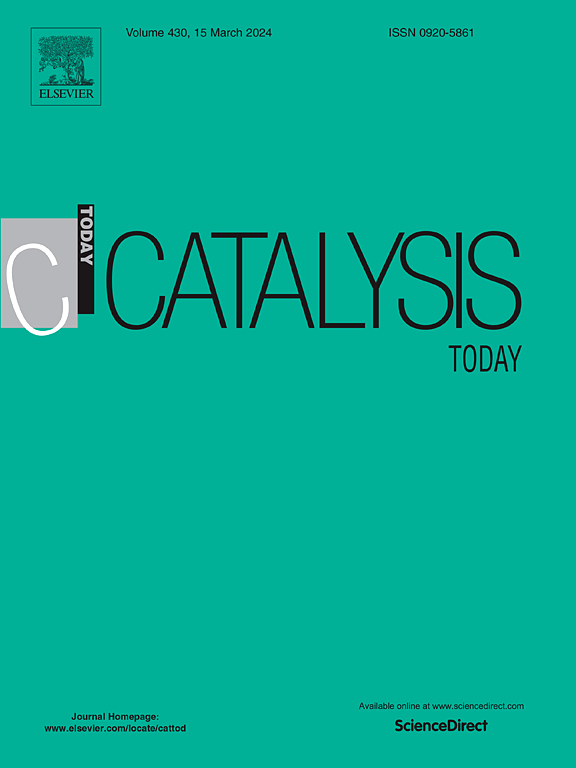Boosting 2,5-furancarboxylic acid formation by improving support surface oxygen activity in AuPd/Ce1-xZrxO2 catalysts
IF 5.2
2区 化学
Q1 CHEMISTRY, APPLIED
引用次数: 0
Abstract
To study the influence of the redox properties of oxide supports on the catalytic properties of AuPd catalysts in the 5-hydroxymethylfurfural (5-HMF) oxidation under weak alkaline conditions, a series of Ce1-xZrxO2 supports (x = 0, 0.5 and 1) and the corresponding bimetallic AuPd/Ce1-xZrxO2 catalysts have been prepared. The samples are studied by X-ray fluorescence spectrometry, X-ray diffraction, Raman spectroscopy, temperature-programmed reduction with hydrogen, and temperature-programmed desorption of ammonia and carbon dioxide. The comparative studies of the AuPd/Ce1-xZrxO2 catalysts show that the active surface oxygen of the Ce-based supports plays a significant role in the aerobic HMF oxidation to 2,5-furancarboxylic acid (FDCA) under weak alkaline conditions (NaHCO3, pH ≈ 8) boosting the 2,5-formylfurancarboxylic acid (FFCA) oxidation stage. PdAu/CeO2 and PdAu/CeZrO2 provide the FDCC yields of 86 and 71.5 %, respectively, at 80 °C, while the main reaction product for the PdAu/ZrO2 catalyst is the FFCA intermediate.
通过提高AuPd/Ce1-xZrxO2催化剂的表面氧活性促进2,5-呋喃羧酸的生成
为了研究氧化载体的氧化还原性能对AuPd催化剂在弱碱性条件下5-羟甲基糠醛(5-HMF)氧化反应中催化性能的影响,制备了一系列Ce1-xZrxO2载体(x = 0,0.5和1)和相应的双金属AuPd/Ce1-xZrxO2催化剂。采用x射线荧光光谱法、x射线衍射法、拉曼光谱法、氢程序升温还原法、氨和二氧化碳程序升温解吸法对样品进行了研究。对AuPd/Ce1-xZrxO2催化剂的对比研究表明,在弱碱性条件(NaHCO3, pH≈8)下,ce基载体的活性表面氧在HMF氧化成2,5-呋喃羧酸(FFCA)的过程中起着重要作用,促进了2,5-甲酰呋喃羧酸(FFCA)的氧化阶段。在80 ℃条件下,PdAu/CeO2和PdAu/CeZrO2的FDCC产率分别为86%和71.5 %,而PdAu/ZrO2催化剂的主要反应产物是FFCA中间体。
本文章由计算机程序翻译,如有差异,请以英文原文为准。
求助全文
约1分钟内获得全文
求助全文
来源期刊

Catalysis Today
化学-工程:化工
CiteScore
11.50
自引率
3.80%
发文量
573
审稿时长
2.9 months
期刊介绍:
Catalysis Today focuses on the rapid publication of original invited papers devoted to currently important topics in catalysis and related subjects. The journal only publishes special issues (Proposing a Catalysis Today Special Issue), each of which is supervised by Guest Editors who recruit individual papers and oversee the peer review process. Catalysis Today offers researchers in the field of catalysis in-depth overviews of topical issues.
Both fundamental and applied aspects of catalysis are covered. Subjects such as catalysis of immobilized organometallic and biocatalytic systems are welcome. Subjects related to catalysis such as experimental techniques, adsorption, process technology, synthesis, in situ characterization, computational, theoretical modeling, imaging and others are included if there is a clear relationship to catalysis.
 求助内容:
求助内容: 应助结果提醒方式:
应助结果提醒方式:


